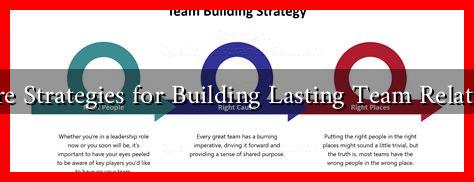-
Table of Contents
- What Are Strategies for Building Lasting Team Relationships
- The Importance of Team Relationships
- Strategies for Building Lasting Team Relationships
- 1. Foster Open Communication
- 2. Build Trust Through Team-Building Activities
- 3. Recognize and Celebrate Achievements
- 4. Encourage Diversity and Inclusion
- 5. Lead by Example
- Case Study: Google’s Project Aristotle
- Conclusion
What Are Strategies for Building Lasting Team Relationships
In today’s fast-paced work environment, the importance of strong team relationships cannot be overstated. Effective collaboration and communication are essential for achieving organizational goals and fostering a positive workplace culture. This article explores various strategies for building lasting team relationships, supported by research, examples, and practical tips.
The Importance of Team Relationships
Strong team relationships lead to improved productivity, higher employee satisfaction, and reduced turnover rates. According to a study by Gallup, teams with high engagement levels can achieve up to 21% greater profitability. Furthermore, organizations with strong team dynamics are more likely to innovate and adapt to changes in the market.
Strategies for Building Lasting Team Relationships
1. Foster Open Communication
Open communication is the cornerstone of any successful team. It encourages transparency and trust among team members. Here are some ways to promote open communication:
- Regular Check-Ins: Schedule weekly or bi-weekly meetings to discuss progress, challenges, and feedback.
- Encourage Feedback: Create a culture where team members feel comfortable sharing their thoughts and suggestions.
- Utilize Collaboration Tools: Leverage tools like Slack, Microsoft Teams, or Asana to facilitate ongoing communication.
2. Build Trust Through Team-Building Activities
Team-building activities can significantly enhance relationships among team members. These activities help break down barriers and foster camaraderie. Consider the following:
- Workshops and Retreats: Organize off-site retreats or workshops focused on team bonding and skill development.
- Social Events: Host informal gatherings, such as team lunches or outings, to strengthen personal connections.
- Volunteer Together: Engage in community service as a team to build a sense of shared purpose.
3. Recognize and Celebrate Achievements
Recognizing individual and team achievements is crucial for maintaining morale and motivation. Celebrating successes fosters a sense of belonging and appreciation. Here are some effective recognition strategies:
- Public Acknowledgment: Highlight achievements in team meetings or company newsletters.
- Incentives and Rewards: Implement a rewards program that recognizes outstanding contributions.
- Personalized Thank-You Notes: A simple handwritten note can go a long way in making team members feel valued.
4. Encourage Diversity and Inclusion
Diverse teams bring a wealth of perspectives and ideas, which can lead to more innovative solutions. To build lasting relationships, it is essential to create an inclusive environment:
- Promote Diverse Hiring Practices: Ensure that recruitment processes are inclusive and attract a diverse pool of candidates.
- Provide Diversity Training: Offer training sessions that educate team members about the importance of diversity and inclusion.
- Celebrate Differences: Acknowledge and celebrate cultural differences within the team.
5. Lead by Example
Leadership plays a critical role in shaping team dynamics. Leaders should model the behaviors they wish to see in their teams:
- Be Approachable: Maintain an open-door policy to encourage team members to share their concerns.
- Demonstrate Empathy: Show understanding and support for team members’ personal and professional challenges.
- Encourage Collaboration: Actively promote teamwork and collaboration in all projects.
Case Study: Google’s Project Aristotle
Google conducted a study known as Project Aristotle to identify the key factors that contribute to effective teams. The research revealed that psychological safety, where team members feel safe to take risks and be vulnerable, was the most significant factor in team success. This finding underscores the importance of fostering an environment where open communication and trust are prioritized.
Conclusion
Building lasting team relationships is essential for fostering a productive and positive work environment. By implementing strategies such as fostering open communication, engaging in team-building activities, recognizing achievements, promoting diversity, and leading by example, organizations can create a cohesive team that thrives on collaboration and innovation. As the workplace continues to evolve, prioritizing team relationships will be crucial for long-term success.
For more insights on team dynamics and relationship building, consider exploring resources from Gallup and Forbes.


